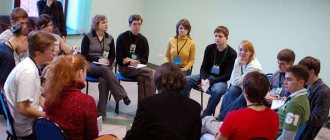Professional growth, age and status
A conversation about a profession covers a fairly long period of life. Some believe that the problem of self-determination can be judged from the emergence of the first thoughts on the topic “What will I become when I grow up?” and up to the moment when a person stops working activity, ceasing to be a person.
The process of personal and professional growth, career development, on the one hand, is closely related to a person’s age. Belonging to an age category often means not so much biological age as position in the hierarchy. The word “youth” in Rus' had the following meanings: “servant”, “slave”, “warrior of the princely squad”. A similar connection exists between professional skills and age. A soldier who served for two years is not called “grandfather” for nothing. To belittle and emphasize immaturity, on the contrary, other words are used - “new guy”, “baby”, “green”.
Psychological science has accumulated a lot of knowledge about what factors influence personal growth in the profession. On the path of life, a person is exposed to various factors, but three of them are of decisive importance .
This is a biological factor (heredity, age, health), social environment (from the family environment to the state), personality activity (depending on self-esteem, level of aspirations, etc.)
A person’s professional development is divided into categories corresponding to age or experience. For example, the following categories of experience : from 1 to 5 years (first), from 6 to 10 (second), from 11 to 15 (third), and so on. Consideration of stages lasting 10 years is also popular.
They also talk about professional development without reference to a specific period, highlighting students, specialists, and retirees. Each stage of professional development ends with a crisis - there is a rethinking of one’s professional activities, the choice of new ways of self-realization.
Methods of personality education
The most optimal approach now seems to be an integrated approach to the educational process, implying the following methods:
- aimed at organizing activities that contribute to the development of experience in behavior in society;
- forming consciousness;
- stimulating behavior.
They mainly serve to convey to the individual knowledge about the phenomena occurring around him. The main distinguishing feature of these methods is their verbal nature. A word that addresses directly to consciousness acts precisely and subtly; in most cases it is capable of pushing the student to think and evaluate his actions. But in isolation from other methods, it is ineffective and does not form stable beliefs.
The child’s knowledge, actions, and emotions are closely related to each other; through them, the teacher can influence the personality, shift the emphasis of influence, achieving certain goals. But only in combination will all measures be effective .
When choosing methods, experienced teachers worry about their suitability:
- principles of learning;
- set goals;
- the content of the task;
- the capabilities of students and teachers;
- conditions of the moment.
Interests, aptitudes, abilities...
The terms “inclinations” and “interests,” although related, are different concepts. Interest in a subject area can create an inclination. Some people like music - they take an interest in it. But one person will be inclined to perform musical works, another will discover a composer in himself, and a third will enjoy teaching an instrument to children.
The activities of radio installers, engineers, and equipment adjusters are different, despite the fact that their interests lie in the same professional plane. If interests are dynamic and can change throughout life, then inclinations speak of inherent abilities, being more stable.
Researchers believe that each profession requires certain inclinations and a set of qualities from a person - they determine whether a person is suitable for this profession or not. Abilities also facilitate personal growth in the profession and the passage of all stages of the career path.
In everyday life, the word “ability” can have different meanings. Sometimes they say about a person’s physical capabilities: “He is able to run 10 kilometers.” Sometimes - about intellectuals - “He is not able to solve this equation.” But in psychology, only those properties that are psychological and that vary from person to person are classified as abilities. For example, every person can speak and is capable of walking upright. However, speech is not classified as an ability; it is not a psychological property. Walking upright is common to all people, so it is not an ability. This quality does not vary.
Personal growth in the profession will be very difficult without a person having certain inclinations. Therefore, the range of skills is limited only to those that will benefit a person during work. Incapable people are different from capable people. For the latter, mastering the profession is easier and faster, and the results of their work are of better quality.
Abilities are a comprehensive education. They include not only a natural predisposition to activity, but also the level of personal development. If you have difficulties determining your inclinations, you can contact a psychologist specializing in career guidance, or representatives of the profession “Personal Growth Coach”. Trainings help you learn a lot of new information about yourself.
Modern approaches
The methods of education today dictate several ways of approaching it.
System
Interprets the emerging personality as a holistic entity. The goals, content and organization of educational activities are maximally interconnected. The systematic approach provides a number of conditions for self-realization, creativity, and individuality development.
Personal development and education
Activity-relational
The pupil is encouraged to engage in various activities that contribute to the acquisition of social experience. The developmental influence of this approach manifests itself only if it evokes internal experiences in the person being educated, forces him to show a positive or negative attitude towards what is happening, and stimulates his own activity.
Personality-oriented
Provides the student with opportunities for self-knowledge and self-realization. Ready-made experience is of little use; the basis for change is always the ability to grow and learn, taking into account your own experience. It is not external factors that play the main role; priority is given to the active personality.
Abilities and personal growth in the profession
However, abilities are not yet a guarantee that a person will be successful in his field. They are a kind of potential for what may or may not happen. Abilities can be compared to grain. Inside it are all the properties that will allow it to grow and become a spike. However, for this to happen, many conditions must be met. Likewise, the fact that a child has musical talents does not in any way mean that he will become a great musician. If there are no adequate conditions - the opportunity to engage in creativity, a favorable atmosphere at home, special education - the disposition to music will die out, never becoming something more.
In addition, inclinations can be realized in different ways. A sociable person with the makings of a leader can spend half his life in unworthy company; or he will be interested in the profession of “personal growth coach.” Someone who is interested in the criminal world can break the law and receive a prison sentence, or he can become a criminal investigator. We will never know the true number of gifted people and geniuses who were not recognized by society.
Until a person masters certain skills, self-realization remains inaccessible to him. Abilities can only be discovered in the process of individual activity. As new knowledge is mastered, a personality is formed. It is impossible to discover a child's ability for mathematics if he is not given the opportunity to learn numbers and mathematical rules.
If a person fails to cope with school or workload, this does not always indicate a lack of ability. Perhaps he needs more time to master the necessary skills and abilities. Once V. Nemirovich-Danchenko was asked a question: can everyone master the profession of director? To this, the playwright and director replied: everyone, but one will need three years for this, another – three decades, and the third – all three hundred.
Heredity and talent
There is a type of family where parents are little interested in the child’s self-realization, his personal preferences and inclinations. Parents tell the child: “In our family, everyone was a doctor,” “You will follow in your father’s footsteps,” etc. It can later be very difficult for such children to change their career path.
However, this approach is not completely unfounded, although the situation with such families itself requires psychological intervention. Plato also held an opinion about the heritability of abilities. He was sure that abilities were exclusively of biological origin, and depended only on who the child’s parents were. Usually, to prove the heritability of talents and abilities, they point to their manifestation in early childhood. After all, the influence of upbringing and training is not yet strong enough in young children to determine the emerging talents.
It is known that Mozart's talent for music manifested itself at the age of 3 years. Haydn - at 4 years old. The idea of inheritance of abilities was adhered to by the English scientist F. Galton. In his opinion, this approach was a logical continuation of Darwin's theory of evolution.
In studies devoted to the heritability of talents, the example of the Bach family is especially striking. Musical abilities in the Bach family appeared in 1550. T. Ribot in his book “The Heredity of Mental Disorders” wrote that baker W. Bach relieved stress after work with the help of singing and music. The baker had two sons, with whom the line of musicians began. In total, there were 60 musicians in the German family, and 20 of them reached significant heights. Only J. S. Bach became known throughout the world.
Scientists also established an interesting fact: L.N. Tolstoy and A.S. Pushkin were distant relatives. Their great-grandmothers, Olga and Evdokia Trubetskoy, were sisters.
Five prominent representatives of German culture were also related by family ties. This is Johann Schiller, whose works have become part of world drama; poet Friedrich Hölderlin; Hegel and Schelling, who stood at the origins of classical German philosophy; as well as theoretical physicist Max Planck. All these people had one ancestor - Immanuel Kant.
Personality qualities
Personality traits in psychology are understood as a unique set of traits and characteristics that are inherent to a person. They are purely personal in nature and express aspects of character, behavioral patterns in society or the surrounding world.
Personal qualities are characterized by dynamism and stability. They influence all aspects of human life, be it the choice of clothes for going out or career preferences and ambitions in professional activities.
Personality traits are classified into several types, for example:
Socio-psychological. Basic and secondary properties, a set of traits and features in the structure of an individual.
Strong-willed. For example, purposefulness, independence, determination, endurance.
Moral. These properties are adjusted by life under the influence of a combination of factors: position in the family; the influence of an educational institution or a yard company; relations in society; individual life experience, etc. Each aspect operates according to specific moral rules. They form the individual’s attitude towards himself and his environment. Based on the values inherent in the inner world, moral qualities are classified into humanistic, nationalistic, racial, religious-fanatical.
Professional, for example:
verbality - language skills, excellent connections between words and concepts love and mastery of numbers - the ability to perform standard arithmetic operations with maximum accuracy and efficiency correction of numbers, three-dimensional understanding of objects detailing of objects and graphics motor coordination by the movement of limbs and eyes, coordination of signals dexterity and color perception general intelligence - a predisposition to learn, the ability to draw correct conclusions from assigned tasks
Development of professional abilities
Regular engagement in a certain type of activity helps to train mental functions and ensures stable personal growth in the profession. It was found that already at the first stage of professional development, young psychiatrists develop the ability to sensitively grasp the emotional state of the patient. For certain skills, certain age periods are the most sensitive. Domestic psychologist B. G. Ananyev found that the best age for developing memory abilities is 18-24 years old, as well as 29-33 years old.
Interesting studies were conducted by psychologists at the University of Bristol. After working on board airplanes for about 5 years, flight attendants began to complain that it was difficult for them to navigate space and remember new information. Psychologists examined flight attendants up to 28 years old, and concluded: their brain volume is indeed reduced, and their cognitive abilities are weakened. Here it is reasonable to argue that older flight attendants think worse than their younger colleagues, and it is not entirely clear who is obliged to train whom.
By the age of 30, a person gradually frees himself from illusions and sensory storms and begins to look at life events with a more realistic look. Researchers note that 15-17 year old boys who were prone to rash and even reprehensible actions become organized and quite competent people by the age of 30. At the age of 30, a person takes stock for the first time: youth is over, and now a serious life lies ahead. If previously the choice of path was made correctly, now the person does not think about changing occupations, he continues his professional growth.
Personal development strategies
So, here are 8 effective ways to take it to the next level:
Go beyond fear
Fear hinders us and limits us. It underlies stagnation in life. We are afraid of the unknown, afraid to face our limitations. Therefore, instead of being brave and taking risks, we passively remain captive to limitations. We may complain about them, but we do nothing to go beyond them.
At what age can you forget about your career?
The most famous unlucky number, “13,” can recently be successfully replaced by “45.” This age has firmly settled in the consciousness of the masses, as a kind of border between “before” and “after”. This is not the first generation that has been influenced by the inhuman phenomenon of ageism - age discrimination. Despite this, gradually the generation for whom their career ends at 50 is being replaced by other people who stubbornly refuse to grow old at 50, 60, or 85. This speaks of progress.
According to some scientists, the stage of youth lasts from 25 to 44 years. This is followed by an average age that lasts up to 60. However, life in Russian conditions has some peculiarities. They inhibit personal growth in the profession and do not allow one to compare the development of people of the same age category living in different countries. For example, the retirement age for a German woman is 67 years. At 50, the German resident feels at the peak of her career - after all, she still has 17 years left before retirement. For comparison, in Russia the feeling of “17 years left until retirement” occurs already at the age of 38-40.
Scientists note that the trend of striving for youth and the opportunities it provides is becoming more and more stable. Many concepts are now becoming a thing of the past - for example, it is difficult to call a well-groomed woman who, in addition to household chores, manages to run her own business, a “housewife”. And the professional development of those who are now very young will continue throughout their lives - perhaps in the future the concept of a pension will disappear.
Self-development in the profession
People engaged in mental work are well aware of the need for self-improvement. However, they are not always able to achieve a certain result - intentions remain intentions.
Personal growth in the profession can be significantly accelerated using special methods. They are engines of self-development even in cases where the level of motivation leaves much to be desired. Let's look at these methods.
Assessment and control of professional qualities and acquired skills.
You can evaluate progress by keeping regular records, or using special tests. At the same time, it is important not to measure acquired skills, but to monitor positive dynamics and qualitative achievements. This way you can track personal growth in the profession, its real indicators. Self-assessment of acquired qualities should not be carried out through introspection - for this it is better to use special tools. Planning is also a form of control.
Drawing up professional goals.
Creating goals and periodically editing them helps you better understand your internal motives - understand why professional development is necessary and what it allows you to achieve.
Development of motivation.
It is necessary to take full responsibility for your own life and career. The more control a person feels over his own life, the happier and more productive he becomes. It is also necessary to work out psychological attitudes regarding crises. Difficult periods often bring opportunities for development. It is especially necessary to maintain a high level of motivation for those whose work is related to communication: this is the work of a teacher, HR manager, or the profession of “personal growth coach.”
Self-discipline.
The minimum period to become a professional is 3 to 5 years. Success does not come by chance, it is a consequence of the choices made by a person. Therefore, in order to achieve professional heights, it is simply necessary to develop existing skills.
Methods of personality formation
⇐ PreviousPage 7 of 7
These methods are used to convey to individuals knowledge about the main events and phenomena of the surrounding world. They are aimed at forming views, concepts, beliefs, ideas, one’s own opinion and assessment of what is happening.
Among the methods of forming the consciousness of an individual, the most often used are beliefs, stories, explanations, clarifications, lectures, ethical conversations, debates, exhortations, suggestions, and examples.
Conviction presupposes reasonable proof of some concept, moral position, assessment of what is happening. Convinced of the correctness of what has been said, they form their own system of views on the world, society, and social relations.
Persuasion as a method of the educational process is implemented through various forms, in particular, excerpts from literary works, historical analogies, biblical parables, and fables are often used. The method of persuasion is also effective during discussions.
The story is used primarily in elementary and middle grades. This is a vivid, emotional presentation of specific facts and events that have moral content. By influencing feelings, the story helps students understand and assimilate the meaning of moral assessments and standards of behavior, forms in them a positive attitude towards actions that comply with moral standards, and influences behavior.
The explanation is characterized by an evidential form of presentation, based on the use of logically related inferences that establish the truth of a given judgment. In many cases, explanations are combined with student observation, teacher-to-student and student-to-teacher questions, and can develop into conversation.
Explanation is resorted to when a student needs to clarify something, communicate about new moral standards, and in one way or another influence his consciousness and feelings. Explanation is used to form or consolidate a new moral quality or form of behavior, as well as to develop the correct attitude towards a certain act that has already been committed. Suggestion is used in cases where the student must accept certain attitudes. It affects the personality as a whole, creating attitudes and motives for activity, and is characterized by the fact that the student uncritically perceives the pedagogical influence. Suggestion enhances the effect of other methods of education. To suggest means to influence feelings, and through them, the mind and will of a person. Exhortation combines a request with explanation and suggestion. A conversation differs from a story in that the teacher listens and takes into account the opinions of the interlocutors, builds his relationship with them on the principles of equality and cooperation. Ethical conversation is called because its subject most often becomes moral, moral, and ethical problems. The purpose of an ethical conversation is to deepen and strengthen moral concepts, generalize and consolidate knowledge, and form a system of moral views and beliefs.
A debate is a lively heated debate on various topics that concern students - political, economic, cultural, aesthetic, legal.
Methods of stimulating the activity and behavior of students
There are methods for stimulating and motivating interest in various types of activities and methods for stimulating duty and responsibility. This includes the creation of situations: emotional and moral experiences, entertainment, novelty, reliance on life experience, success in various types of activities, as well as games, discussions, methods of reflection and others. Effective methods of stimulating and motivating activity and behavior include the following classic situations created by the teacher:
□ The situation of advances by trust (A. S. Makarenko) is characterized by the fact that conditions are created for the expression of trust on the part of other children or an adult significant to the child.
□ A situation of free choice - the student is faced with the need to make an independent choice of one or another action, type of activity, etc.
□ The situation of correlation (X. J Liimets) involves an assessment, decision-making and action based on existing experience. The teacher creates a similar situation, for example, when it is necessary to encourage a student to self-education.
□ A situation of success (O. S. Gazman, V. A. Karakovsky and others) is created in the case when it is necessary to support a group of students, an individual student, consolidate the positive in their development, overcome self-doubt, etc. A necessary condition for This is the desire of an individual or group to achieve success and make efforts to achieve it.
□ The situation of creativity (V.A. Karakovsky) is to create conditions for the development of schoolchildren’s creative abilities, their imagination, fantasy, ability to improvise, ability to get out of a non-standard situation, etc.
□ The situation of competition (A. N. Lutoshkin) evokes the desire to be better, as well as the corresponding volitional effort and, as a result, the achievement of better performance. This is usually confirmed by official recognition: a prize, number of points, diploma, diploma, etc. Competition is a method of stimulating the activity of students by creating conditions in which each participant strives to demonstrate their abilities to the maximum and achieve better results compared to other participants. Competition contributes to the formation of the qualities of a competitive personality. This method is based on the child’s natural inclinations towards leadership and competition. The effectiveness of competition increases when students' activities are saturated with situations of experiencing success.
Traditional methods of stimulating activity and behavior are methods of reward and punishment. Encouragement is a way of expressing a positive assessment of the actions of students, public recognition of the course of action that is chosen and implemented by the student in practice. Encouragement reinforces positive habits and behavioral skills, arouses positive emotions, and instills confidence in one’s own abilities. Forms of encouragement: approval, praise, gratitude, granting honorary rights, rewarding and others. Despite its apparent simplicity, this method requires careful use. Encouragement should evaluate not so much the result as the motive and method of activity. The student should not be taught to expect reward for the slightest success. It is important that encouragement is a natural consequence of the student’s action, and not a consequence of his desire to receive encouragement. Particularly in need of encouragement are timid, insecure students, as well as those who are especially sensitive to the assessment of their actions and behavior in general. The attitude towards punishment as a method of education in pedagogy is ambiguous and contradictory. Punishment is an impact on a person that expresses condemnation of actions and deeds that are contrary to the norms of social behavior and forces students to strictly follow them. Punishment corrects the child’s behavior, makes him understand where and what he did wrong, causes a feeling of guilt towards himself and others, a feeling of shame, discomfort, and dissatisfaction with himself. This condition may develop into a need to change one's behavior. Such types of punishment as the imposition of additional duties, deprivation or restriction of certain rights, censure, condemnation are known. In any case, the punishment must be fair, understood by the student (analysis of the causes and conditions that led to the offense), and must not humiliate his dignity or cause him moral or physical suffering.
Types of education
Education is a purposeful and organized process of personality formation; it is the transfer of accumulated experience from older generations to younger ones. Experience is understood as knowledge, skills, ways of thinking, moral, ethical, legal norms known to people - in a word, all the spiritual heritage of humanity created in the process of historical development.
Types of education:
— Mental education is the mental, moral, emotional and physical development of the individual, the disclosure of his creative potential. Conscious assimilation of a knowledge system contributes to the development of logical thinking, memory, attention, imagination, mental abilities, inclinations and talents.
— Physical education is an integral part of almost all educational systems. Physical education contributes to the development in young people of the qualities necessary for successful mental and labor activity.
— Labor education — covers those aspects of the educational process where labor actions are formed, production relations are formed, tools of labor and methods of their use are studied. Labor in the process of education also acts as a leading factor in personal development.
— Polytechnic education is aimed at familiarizing with the basic principles of all industries, acquiring knowledge about modern production processes and relationships. The main tasks of polytechnic education are the formation of interest in production activities, the development of technical abilities, new economic thinking, ingenuity, and the beginnings of entrepreneurship.
— Moral education — forms moral concepts, judgments, feelings and beliefs, skills and habits of behavior that correspond to the norms of society. The moral education of the younger generation is based on both universal human values, enduring moral norms developed by people in the process of historical development of society, and new principles and norms that have arisen at the present stage of development of society.
— Aesthetic education is a basic component of the goals of education and the educational system, summarizing the development of aesthetic ideals, needs and tastes among students. The tasks of aesthetic education can be conditionally divided into two groups - the acquisition of theoretical knowledge and the formation of practical skills. The first group of tasks solves the issues of familiarization with aesthetic values, and the second - active inclusion in aesthetic activities.
Principles of training
The principles of teaching are the conditions on the basis of which the teaching activity of the teacher and the cognitive activity of the student are built.
The development of teaching principles began several centuries ago. For the first time, teacher Jan Komensky spoke and tried to formulate the principles of teaching. In his work “The Great Didactics,” he called them the fundamental principles on which the entire pedagogical process should be built.
K. D. Ushinsky played an invaluable role in the development of teaching principles.
— The principle of consciousness and activity. This principle reflects the need to develop motivation for learning and stimulate learning activities.
— The principle of visualization has been popular since ancient times and is quite effective, being intuitive. Using visual material where possible, the teacher opens up another channel of perception for students - the visual, which significantly increases the efficiency of learning.
— The principle of systematicity and consistency gives a systematic character to the learning process, which is a necessary condition for the effectiveness of any impact. The skills and abilities already acquired by a person in the learning process must be systematically applied in real or artificially created conditions, otherwise they begin to weaken
— The principle of strength. The goal of this principle is the strong and long-term assimilation of the acquired knowledge. This goal is achieved by developing the student’s interest and positive attitude towards the discipline being studied. To do this, the teacher must strive to establish positive emotional contact with students.
— The principle of accessibility implies the development of the content of the learning process taking into account the capabilities of students. An important condition for accessibility is the correct sequence of presentation of educational material. To learn new information, the student must have appropriate basic knowledge. It is necessary to correlate the complexity and volume of new knowledge with the age of students and their individual characteristics, such as health, learning ability, and psychophysical state.
— The scientific principle consists in the careful selection of information that makes up the content of training, meeting the following requirements: students should be offered to master only firmly established, scientifically based knowledge, methods of presenting this knowledge should correspond to a specific scientific field.
— The principle of connection between theory and practice is based on the central concept of philosophy: practice is the main material for knowledge. Practical activity plays an undeniably large role in pedagogical science. Practical knowledge obtained is the most reliable source of information.
⇐ Previous7
Recommended pages:









